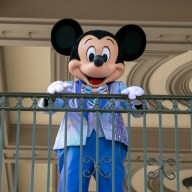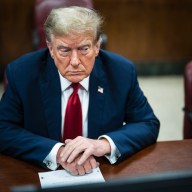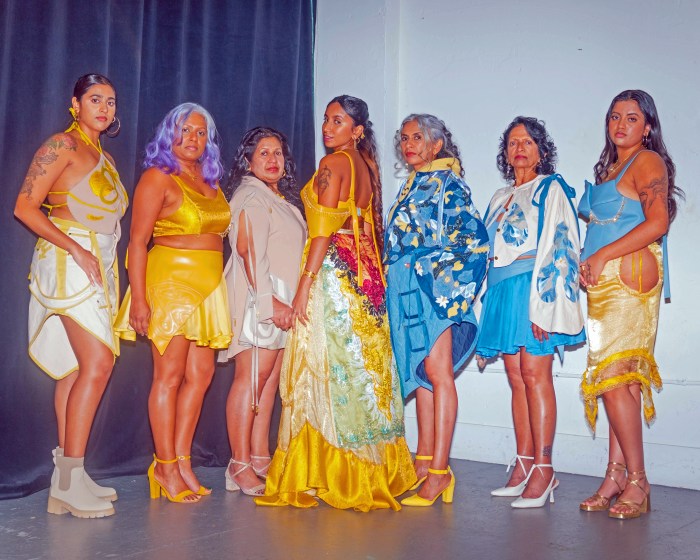 Steve Locke in his studio. Photo: Liza Voll
Steve Locke in his studio. Photo: Liza Voll
Boston-based artist Steve Locke has been making art for more than two decades. The Massachusetts College of Art and Design prof has exhibited at small, independent galleries and spaces around town includingSamsøn, the Rhys Gallery (since relocated to L.A.), and more but, surprisingly, has never shown his work in a major museum show. Until now. Locke’s”there is no one left to blame” — a collection of eclectic paintings featuring, most prominently, brightly colored images of men sticking out their tongues — opens at the Institute of Contemporary Art on July 31st. We sat Locke down before the exhibit’s big unveiling to talk contemporary art, altered bodies and two hookers he used to know.
What can people expect when they come to see your show?
Well, they’re going to see a lot of paintings, and they’re going to be in different forms. Some of them are going to be on the floor, and some of them are going to be on the wall, and then some of them are going to be IN the wall. There’s also going to be a neon sign, that says “there’s no one left to blame,” which is the title of the show. I have painted portraits my whole artistic career and this body of work really focuses on the thing that I’m interested in, which is the head, as a carrier of meaning. There’s also a different kind of understanding of what the body is, and what the body can do. So that’s what people can expect to see. There’s something for everyone, is what I like to tell people.
What is it about the head that’s so compelling for you?
We have this crazy notion that form and content are separate, right? But form and content come together in the body. Like, you have a form, and you have a content, you have an interior life. So it’s automatic to me that the body would be a way of communicating content, just using the body. And there’s the notion of the head being the end of something, or the beginning of something. And also we see a lot of bodies right now that have been altered by war, altered by surgery or altered by Photoshop. So to me it makes perfect sense to have a painterly investigation of all the ways that the male body has been investigated. So that’s really the crux of what’s happening in the show.
How has the ICA been as a home for your first show?
Oh, they’re heavenly. You couldn’t ask for better. I have said to people before [that] I never expected anybody to be remotely interested in anything I did as an artist. That’s not why I became an artist. I wanted to make pictures, that’s the only reason I became an artist, and I thought if people saw them, that would be great. I love art, I love the art world, I go to museums all the time, and it’s beyond my wildest dream that I would actually have work in a museum. To be alive when my work is being shown in a museum, I’m over the moon about it.
What do you think makes the ICA unique, as a museum?
The idea of a contemporary art museum is a relatively new thing. If you asked someone like Jackson Pollock or David Smith what they thought of museums, they would have said they’re for dead people because museums didn’t show contemporary art. To be where it is and do what it does, which is show the art of our time, is incredibly important. The art of our time talks about our time, so it’s not just things that are easily understandable or easily digestible. There are some things that are really difficult, and some things that are really beautiful and some things that are really terrible and beautiful at the same time. Because that’s what contemporary life is. It can be really amazing and really awful at the same time, and contemporary art can show us that. That’s what they [the ICA] do better than anybody.
How does teaching affect your own work?
It’s really great to be in contact with young artists. That’s the exciting thing, to watch people make these discoveries, and to have them find their own voice. It keeps alive a sense of risk in your own work. When you’re telling someone that they have really have to risk something in their own practice, you have to do the same thing in your own, otherwise you’re a phony. I think that students can always spot a phony. I think that if you’re not doing it in your own practice, and then you go and try to teach somebody, your students will see right through you, so it really does keep you on your toes. And I love my students, they’re just wonderful.
Which has been your favorite place to have a studio?
I loved having a studio in the South End because you’re so close to everything. You could have a problem in your studio and walk right up to Back Bay Station and get on the Orange Line or get on the 39 bus and you’re at the MFA and you could go look at something. Or you could walk right over to the old ICA, which was over on Boylston Street, which was like a ten minute walk. Walk there and walk back, look at something interesting and get back to work.It was terrific. The studio was over on Harrison Avenue, and there were two hookers who lived downstairs. They worked different shifts. Like, one was in the morning, one was in the evening. So I would come back from work and one of the hookers would have my packages. It was great. They were really great ladies. I think in the old South End, people really did look out for each other.














